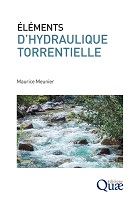Éléments d'hydraulique torrentielle
Abstract
Torrential hydraulics occupies an intermediate position between classical fluvial hydraulics and soil and rock mechanics (ground movements); it uses concepts common to fluvial hydraulics, sometimes departing from them.
Published in 1992, this book sets out the problems specific to torrent hydraulics, describing the particular phenomenon of debris flow through a qualitative description of a famous debris-flowing torrent and its workings. Shifts in meaning also affect certain concepts when moving from river hydraulics to torrential hydraulics: viscosity and concentration are more complex to use in torrential hydraulics.
New theories are then presented: fluid mechanics-type research work that tackles the problem of which model to apply to which torrential flow, starting with knowledge of the behavior law (rheology) and ending with knowledge of the flow law.
Many of the tools developed by researchers are still far from being directly applicable to engineering problems, apart from physical scale models. This study then focuses on methods that can be used by people in the field: we will no longer talk about behavior laws and velocity profiles, but only about average velocities. This change in the level of our approach will enable us to use the few existing field measurements, which until now have only concerned the global parameters of torrential flows. A book for students and teachers with a scientific background in classical hydraulics.


 Download
Download